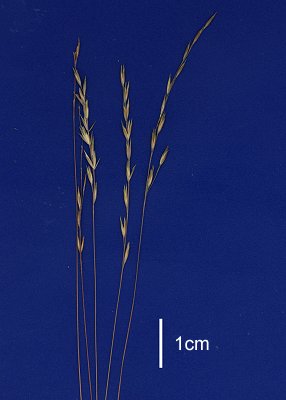Eriachne fastigiata Lazarides. J.
& Proc. Roy. Soc. Western Australia 42: 33 (1959).
Classification. (GPWG 2001) : Subfamily Micrairoideae. Eriachneae.
Type of Basionym or
Protologue Information: Australia: Western Australia: near Clifton Creek,
2.5 mi NW of Glenroy Meatworks, 22 Apr 1955, Lazarides 5142 (HT: CANB).
Key references
(books and floras): [2002] D.Sharp & B.K.Simon, AusGrass, Grasses of
Australia.
Illustrations:
[2005] K.Mallet (ed.), Flora of Australia 44B: Poaceae 3 (Fig.
28D-E).
Habit. Annual.
Culms stature slender to delicate, 27–50 cm tall, wiry, 2–4 -noded. Mid-culm
internodes glabrous or pubescent. Mid-culm nodes glabrous. Lateral branches
branched or fastigiate. Leaves mostly basal. Leaf-sheaths hairy. Ligule a
fringe of hairs, 1 mm long. Leaf-blades erect or recurved, lanceolate, 1.5–2.5
cm long, 1.5–3 mm wide. Leaf-blade surface scaberulous or scabrous, indumented.
Inflorescence.
Inflorescence compound, a panicle. Panicle linear, 2.5–4.5 cm long, 1–2 cm
wide.
Spikelets.
Spikelets pedicelled. Fertile spikelets 2-flowered, both fertile, comprising 2
fertile floret(s), without rachilla extension, cuneate, laterally compressed,
3–4 mm long.
Glumes.
Glumes similar, thinner than fertile lemma. Lower glume elliptic, membranous,
much thinner on margins, without keels, 5–7 -nerved. Lower glume surface
glabrous. Upper glume elliptic, 2.7–4.5 mm long, membranous, without keels, 5–7
-nerved. Upper glume surface smooth, glabrous.
Florets.
Fertile lemma 3–5.5 mm long, without keel, 5–7 -nerved. Lemma surface
indumented. Lemma apex muticous. Palea apex entire or erose, muticous. Anthers
3. Grain 2–2.8 mm long.
Continental
Distribution: Australasia.
Australian
Distribution: Western Australia, Northern Territory.
Western Australia:
Gardner, Fitzgerald, Hall. Northern Territory: Darwin & Gulf,
Victoria River.
Flora
of Australia Notes. Diagnostic features include the reduced racemose
inflorescence, obliquely attached glumes, florets longer than glumes, awnless
sparsely pubescent lemmas, acute pubescent callus with glabrous tip, and the
ribbed glumes and lemmas. Another distinctive character is the ciliolate keels
of the palea, by contrast to the glabrous condition which characterises the
genus. The branching habit of plants is also distinctive. An elongated
internode separates the short, lower culm internodes from the upper one or two
nodes, which fastigiately produce numerous spikelet-bearing branches. E.
fastigiata resembles E. pulchella in branching habit, but differs by
its taller dimensions, panicle structure, and the morphology and indumentum of
its spikelets.
Endemic.
Central and NE Kimberley region of W.A., and N.T. Occurs in skeletal, stony
soil and shallow pockets on shale, sandstone, granite and basalt. Flowers and
fruits Feb.-June (late-summer to early-winter).





